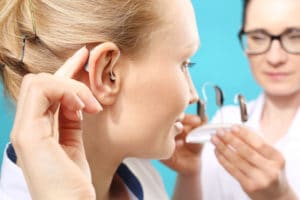If you’re having trouble with your hearing in Salem, it’s important you schedule an appointment with an audiologist.
There are a wide range of physical, psychological and social complications associated with untreated hearing loss, so you’ll want to find a solution as soon as possible.
If you’ve never been to an audiologist before you may be a little nervous and unsure of what to expect, but there is nothing to worry about. We’ll let you know exactly what to expect.
What Does an Audiologist Do?

Your audiologist is a health care professional trained in the diagnosis and treatment of hearing and balance disorders.
Audiologists rely on different tests and procedures to assess hearing and balance function and fit and dispense hearing aids and assisted listening devices. They are here to help you hear more easily, communicate effectively and enjoy a better quality of life.
Your first visit to a Salem audiologist will involve the following:
- Paperwork. Paperwork is a necessary evil for all new patients. Your audiologist will need information regarding your medical history, medications you are taking and hearing concerns you are having. Don’t forget to bring photo identification and health insurance information.
- Physical exam. Your audiologist will examine your ears for abnormalities or medical conditions using a lighted instrument called an otoscope. They will be looking for anything that might interfere with your hearing. Sometimes, something innocuous such as too much earwax can cause hearing problems.
- Hearing screening. To determine the type and extent of your hearing loss, you’ll be given a hearing screening – a series of tests that measure the hearing ability of different parts of your ears. Your hearing screening may involve one (or all) of the following tests:
- Air Conduction Testing. Also known as pure tone audiometry, air conduction testing measures your ability to hear sounds at various pitches and volumes. Your results are charted on a graph called an audiogram.
- Bone Conduction Testing. Bone conduction testing measures the inner ear’s response to sound. Results are compared to those of your air conduction test to determine your type of hearing loss.
- Speech Testing. This simple test measures your speech reception threshold, which is the faintest speech you can understand 50 percent of the time. You’ll simply be asked to repeat words and phrases delivered in both quiet and noisy environments – information that will let your audiologist determine your ability to separate speech from background noise.
- Tympanometry. This test measures your eardrum’s movement in response to air pressure. Lack of movement may be indicative of earwax buildup, a ruptured eardrum or a benign tumor.
- Acoustic Reflex Testing. Acoustic reflex testing measures muscle contractions of the middle ear and helps determine the type and location of your hearing impairment.
- Auditory Brainstem Response. ABR testing is primarily used to confirm that you have sensorineural hearing loss of the inner ear. It is often used in newborn hearing screenings.
- Otoacoustic Emissions. OAEs are faint sounds the cochlea produces in response to stimulation. OAE testing checks for blockages in the ear canal, fluid buildup in the middle ear and damage to the hair cells of the cochlea. Like ABR testing, it is often used in newborn hearing screenings.
You’ll need to schedule a follow-up appointment once your Salem audiologist has had a chance to go over your results and determine a treatment solution for your hearing loss. At least you won’t have to fill out all that paperwork the next time around!
“Dr. Strand is wonderful. In fact, all the staff are just the best. Personable, and to the point. You will be well cared for at Willamette ENT.”